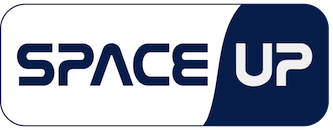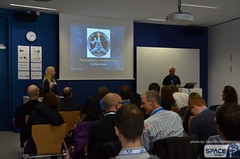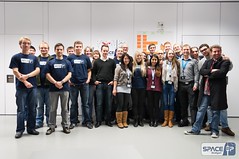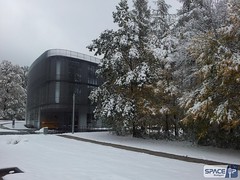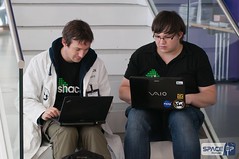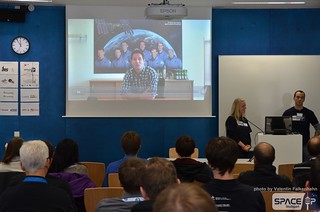SpaceUp Stuttgart – Germany’s First Space Unconference
by Anja Frey and Andreas Hornig
Despite the surprise of this season’s first snow, space enthusiasts with very diverse backgrounds made their way to Stuttgart on October 27th for Germany’s first SpaceUp. Their effort was rewarded with interesting talks and people at SpaceUp Stuttgart, a space unconference . Unconferences are unconventional conferences. This means that there are no observers, only active participants. In contrast to regular conferences, for which you have to apply with an abstract and be accepted as a presenter, unconference participants simply prepare a little post-it note and stick it on the session grid wherever there is a free slot. In this way the unconference program is created spontaneously. SpaceUp was started in the U.S.A. where it spread quickly to several cities. The success of the American SpaceUps caused the concept to be exported all over the world, with new SpaceUps being founded regularly. Now, we brought SpaceUp to Germany for the first time!
The SpaceUp Stuttgart organizing team, Anja Frey and Andreas Hornig, are Aerospace Engineering students at the University of Stuttgart. They are volunteers who organize SpaceUp Stuttgart in order to share their passion about space. They wanted to use this unconference as a tool to raise awareness about space and an opportunity for space enthusiasts to exchange their ideas.
The event was free in order to enable everybody who is interested in space to be a part of it. Although the first snow may have kept a few registered participants from attending the unconference, there were more participants than originally expected. SpaceUp Stuttgart was a great event with inspiring talks, plenty of breaks, and time to get to know the other participants and discuss space topics. In essence, this is the very spirit of an unconference.
It’s All About the Participants
Of the 63 participants who had registered ahead of time, 49 attended SpaceUp Stuttgart. Keeping true to the unconference theme, participants were not required to register, leading to a total of 77 space enthusiasts assembled for Germany’s first SpaceUp. Among others, representatives of European Space Agency (ESA), German Aerospace Center (DLR), University of Stuttgart, International Space University, Mars Society Deutschland, German Society for Aeronautics and Astronautics (DGLR), SpaceUp EU, Scientific Workgroup for Rocketry and Spaceflight (WARR), NEOshield, EADS Astrium, Fraunhofer IISB, VEXREDUS, and Space Generation Advisory Council were present. Besides experts from the space sector, the organizers specifically invited students and non-professional individuals with an interest in space. According to the unwritten first rule of unconferences, all participants were equal and given the same amount of time. This was not only a great opportunity for the laymen to learn from renowned specialists but also for the professionals to get in touch with the next generation and be inspired by presentations about student projects and new ideas.
Thanks to the great help of Eva Dresel, Vanessa Kolb, Paul Rinck, August Bohn, Valentin Falkenhahn, Julian Franz, Marcel Frommelt, Ferdinand Hertel, Julian Herzog and Alex Liefke, everything went smoothly. They made sure the participants got their food and drinks on time, helped set up and clean up, filmed the presentations, took photos, registered the participants, and ensured that the event was perfect.
A Great Venue for an Amazing Space Unconference
The venue for SpaceUp Stuttgart was the modern Space Center Baden-Württemberg on the University of Stuttgart campus.
Thanks to its sophisticated architecture, the Space Center was the ideal choice of venue. The exhibits of satellite mock-ups and technology samples of thrusters and experiments, created a very special atmosphere adding to the SpaceUp experience. Besides the foyer, which was used for coffee and lunch breaks as well as the get-together after the sessions ended, three rooms were available for presentations. Furthermore, it is perfectly located in an area close to southern Germany, Switzerland and France. This location is very easily accessible by car and public transportation, thus enabling all participants to get there comfortably.
Living Session Grid
Since SpaceUp is an unconference, the program was not predetermined. The organizing team sent a preliminary suggested session grid based on the registrations to the participants in order to ease the logistical challenge of accommodating the overwhelming range of proposed talks and discussions.
A short welcome by the hosts Andreas Hornig and Anja Frey was followed by an introduction of the Space Center Baden Württemberg and the Institute of Space Systems by Prof. Dr. Röser, Director of the Institute of Space Systems. A scheduled break was next so that the participants had enough time to post their talks onto the session grid. Throughout the entire day the participants kept adjusting the session grid, finding a free slot for their presentation or grouping them with similar topics. A total of three sessions with twenty presentations and four 60 seconds to land videos in three rooms were the result.
Space Talks and Discussions
The first session was started by DLR spokesman Andreas Schütz talking about “Wissenschafts- & Krisenkommunikation” (“Science and Crisis Communication”). He was followed by ESA’s Rüdiger Jehn whose topic was “What is wrong with Mercury?”. Rüdiger explained that with its several sunsets and rises in a nick of time, Mercury is a planet for romantics. In the next room, Michael Deiml from the Technical University of Munich,
challenged his audience to decide which one of the WARR projects he would introduce to them. He was followed by Tobias Willerding from the HyEnD group at the University of Stuttgart. Tobias informed us of their hybrid rocket project. At the same time, Fernanda Maia presented the “Development Model of a Green Monoprop Thruster” prior to Claas Ziemke from OpenSimKit describing “System Simulation for dummies” in room three.
Immediately after the lunch break, ISU’s Chris Welch fascinated his audience by introducing the “Institute for Interstellar Studies”. Lothar Frey, Director of Fraunhofer IISB, explained “Cosmic Rays and Electronic Devices”. This presentation was followed by the ESA EAC delegation, Loredana Bessone and Pascal Renten who talked about “Training for Human Spaceflight using Analogues”.
They showed an intriguing movie about the ESA CAVES mission. Simultaneously, Paul Nizenkov and Graeme Taylor presented their project “Establishment of a Spaceport Network Architecture”.
In room three, the participants met two representatives of shack e.V.: hadez told them about “Hackerspace Global Grid (HGG) for Distributed Groundstation Network”, while Timm talked about “Flutter – Timing Module of HGG”.
The final session was kicked off by Wissam Rammo from EADS Astrium who presented “InSight – Geophysical Monitoring Station Mission”. He was followed by Nicolay Kübler with “Mars Simulation on Earth” and Hannes Griebel with “The MIRIAM Flight Testing Concept: Dress Rehearsal for ARCHIMEDES”, both from the Mars Society Deutschland. Tobias Kuhn from the University of Stuttgart explained the VEXREDUS project and the “Rexus Bexus Student Experiment Campaign”. Next up was Dave Haslam who introduced the participants to the International Space University and their programs. Roland Gabrielli from the Institute of Space Systems gave a “Brief Overview on Current European Activities for the Sustainable Development of the Outer Solar System”. The program continued with Araba-Molly Acquaisie from NEOShield Astrium who talked about “NEOShield: Preparing to Protect the Planet!”. The final presentation was given by SpaceUp Europe organizer Remco Timmermanns who gave a T-5 talk on “Baikonur” and his trip to this very special place.
The sessions were moderated by Anja Frey, Andreas Hornig, Jennifer Neffgen and Manfred Ehresmann. After the sessions had ended the participants met up in the foyer for drinks, discussions, and getting to know each other.
60 Seconds to Land or Crash
SpaceUp Stuttgart started a new category for SpaceUps: The “60 Seconds to Land” videos. They are designed to provide a platform for those who could not make it to SpaceUp Stuttgart in person to present their projects, share their ideas and just say “hi” to the participants.
The first video was received from the European Astronaut Center.
ESA Astronaut Thomas Pesquet sent greetings to SpaceUp Stuttgart, encouraging the participants to keep talking about space. Thomas Sinn used this opportunity to introduce “Suaineadh (REXUS12)” and “StrathSat-R” in two short videos. Luca Foresta from the Austrian Space Forum OEWF took the audience into their Suit Lab for the Morocco Mars Analog Simulation. Their video raised the question “Why do you do Morocco Mars Analog Simulation and not at Mars Desert Research Station (MDRS)?” among the participants. We forwarded the question to OEWF and they answered via social media.
Three additional videos will be used exclusively online. In these “60 Seconds to Land” videos the Forschungsgemeinschaft Alternative Raumfahrt (FAR) presents their projects, the Blue Marble Initiative promotes their “One Flag in Space” campaign, and the organizers invite to India’s first SpaceUp.
Social Media and Participant Feedback
In order to promote SpaceUp Stuttgart on a small budget with a maximum impact the organizing team used social media. The Twitter accounts @spaceupstgt and @60secondstoland reached 120 followers and the Facebook page SpaceUpStuttgart achieved more than 140 “Likes” in a little over two months. The promotional YouTube video “SpaceUp Stuttgart – Your Space Unconference Unworded (Deutsch)” generated more than 700 clicks by October 2012.
The feedback, during and after the event was excellent. Participants tweeted during the talks and reached a large audience of interested followers. After reading our tweet about the frist snow Alex @4tuneQkie tweeted
“Love to read tweets about #SpaceUp We send sun from Florida to #SnowUp @SpaceUpStgt today! Enjoy #space at its best! @SpaceUpConf”
Remco Timmermanns @timmermannsr proclaimed via Twitter
“The last 132 #SpaceUp tweets generated 337,440 impressions, reaching an audience of 132,134 people. Not bad! cc @SpaceUpStgt”
on October 28th at 3:54 a.m.. Rüdiger Jehn blogged “What is an UNconference?” in the ESA rocket science category. The local newspaper Stuttgarter Zeitung published an article the very same day titled “SpaceUp in Stutgart – Von Sonnenstürmen und Plasmapartikeln (Of Solar Storms and Plasma Particles)”. NEOshield posted an article about “NEOshield presents at SpaceUp Stuttgart 2012” in their newsfeed. Participants told the organizers they had a great time and are looking forward to organizing their own SpaceUp soon. Naturally, we cannot wait to attend their SpaceUps!
We took videos of all the presentations in order to put them online. This is a great chance for those who could not make it to SpaceUp Stuttgart to listen to the inspiring presentations and get a better idea about SpaceUp.
Result
Overall, SpaceUp Stuttgart was a great success! Even though we were surprised by an early snowstorm, more participants than expected attended the unconference. The very diverse presentations provided a variety of topics so that everyone could find a talk in which they were especially interested in. The new category “60 Seconds to Land” was received very well and will most likely be incorporated in future SpaceUps all over the world. The Space Center Baden-Württemberg proved itself to be a great venue for SpaceUp Stuttgart. Most importantly, both the participants and the organizers enjoyed the event tremendously and are looking forward to the sequel.
References:
SpaceUp Stuttgart
Contact: spaceupstuttgart@aerospaceresearch.net
Web:
- “What is an Unconfrence?” by Rüdiger Jehn at ESA Blog
- „SpaceUp in Stuttgart – Von Sonnenstürmen und Plasmapartikeln (Of Solar Storms and Plasma Particles)“, Alexander Mäder,
- All SpaceUp Stuttgart images on Flickr
